Industry Leader. Catalyst Handling Specialists.
Setting New Standards with proprietary, specialized equipment, managed by our expert teams, to deliver catalyst handling projects safely and with cost-conservation across the entire project.
After successfully completing over 10,000 catalyst projects, CHR is at the top of catalyst handling specialists worldwide.
Our people are among the best trained and experienced in the industry. Our equipment is designed and built for efficient transport, set up, catalyst loading and unloading, removal and reinstallation.
CHR has experience in a wide range of reactors in oil refining, gas processing, petrochemical, chemical and air separation plants.
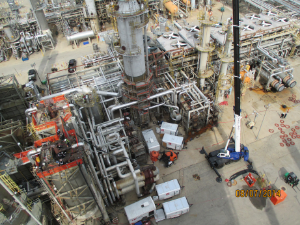
Catalyst Unloading
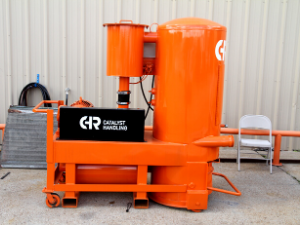
Dust Collector
Dust Control
Under CHR Zero Harm deliverables, we keep a strong focus on dust control.
Dust is created during production, transport, storage and handling of catalyst and in various stages of catalyst unloading, transferring, reloading, screening and packaging.
Through pre-planning, attrition prevention, and use of in-house designed dust collection systems at various point in the process, CHR is able to eliminate dust emission.
Cost Control
Cost control is important and CHR will deliver the most effective cost solution to catalyst handling projects. We achieve this through:
- Offering a one-stop solution to reactor maintenance including, mechanical (blind to blind), internal modifications (CHR holds R-stamp certification), tray installations, process and logistical services
- Reducing cost of downtime due to experienced, solution driven project management able to work through challenges quickly and in consultation with the client
- Reducing the cost of Nitrogen
- Fast response to emergency shut-downs
We are more than efficient, we drive down costs!
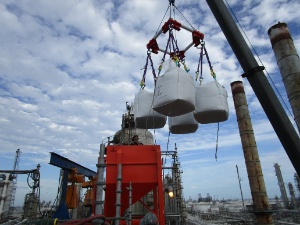
Four Bag Loader
Catalyst Unloading
 Catalyst Handling Resources has a range of options for the unloading reactors, vessels, and columns. The majority of our equipment is proprietary and we constantly review our equipment to incorporate best-practice procedures and methods.
Catalyst Handling Resources has a range of options for the unloading reactors, vessels, and columns. The majority of our equipment is proprietary and we constantly review our equipment to incorporate best-practice procedures and methods.
We offer complete “blind to blind” services for reactors, vessels, and columns from one integrated team. CHR can blind and open vessels, complete internal repairs and close and de-blind vessels.
Gravity Unloading and Dust Control
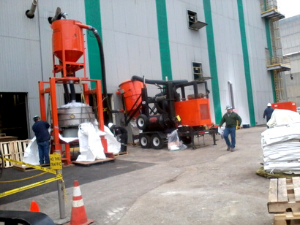 CHR material handling equipment can collect, transport, and transfer reactor catalyst from the dump nozzle to any size container requested. Our external dust collectors recover air born particulate created during the material transfer phase of collection.
CHR material handling equipment can collect, transport, and transfer reactor catalyst from the dump nozzle to any size container requested. Our external dust collectors recover air born particulate created during the material transfer phase of collection.
In areas where access is difficult or for unloading horizontal dump nozzles we have enclosed conveyors and screw conveyors that can assist with the removal of catalyst from the most difficult of locations.
Vacuum Method
Catalyst unloading is typically accomplished by vacuuming from the entry manway, dumping from the unloading nozzle or flange at the base of the reactor, or a combination of both. Unloading using the vacuum method is normally required under the following circumstances: removal of top support and upper zone catalyst only, known as a reactor skim:
- When gravity unloading is not an option
- When bed rotation or separation of different catalyst types is desirable
- Where sampling of catalyst at different zones is needed for evaluation
- For total recovery of precious metals or hazardous materials
- When space, access, or the reactor design dictates
- To retain support for reuse, it may be more economical to skim and classify the support rather than screen and classify the entire charge
CHR has designed and fabricated its catalyst handling equipment to the specific criteria required for proper catalyst handling. High capacity vacuum blowers, cyclone separators and Continuous Discharge hoppers enable catalyst removal at high rates; with little or no damage to catalyst particles. We accomplish vacuum unloading in atmospheric or inert conditions.
A major consideration when vacuuming an inert purged reactor is the conservation of Nitrogen and maintenance of the inert atmosphere. The re-circulation and cooling system used by Catalyst Handling assures both the optimum use of the Nitrogen and the maintenance of safe levels of Nitrogen to work within.
Inert Entry
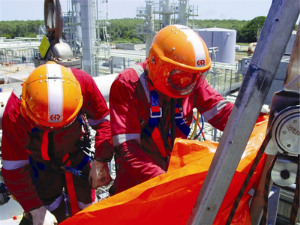
Should Immediately Dangerous to Life or Health (IDLH) entries or rescue services be required, we are prepared.
Catalyst handling Resources maintains the trained personnel, procedures, equipment, expertise, and most importantly, the experience necessary to ensure the safe completion of work or the provision of safety teams for stand by rescue services.
Life Support System
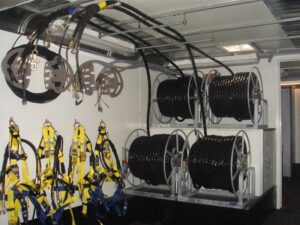 The CHR Life Support System is fully NIOSH, OSHA and CE accredited and consists of multiple air supplies that feed the lock on helmets to ensure a constant supply of air to technicians. The system also incorporates hard line communication, an egress bottle, a full body harness, and a fall arrest system. Video cameras are used to monitor all aspects of the inert entry operation Up to 4 helmet cameras can be viewed at any time and an additional stand-alone camera can also be connected to the system. Full recordings can be made of the work completed for both quality assurance purposes and as a record of repairs.
The CHR Life Support System is fully NIOSH, OSHA and CE accredited and consists of multiple air supplies that feed the lock on helmets to ensure a constant supply of air to technicians. The system also incorporates hard line communication, an egress bottle, a full body harness, and a fall arrest system. Video cameras are used to monitor all aspects of the inert entry operation Up to 4 helmet cameras can be viewed at any time and an additional stand-alone camera can also be connected to the system. Full recordings can be made of the work completed for both quality assurance purposes and as a record of repairs.
Our life support equipment is trailerized and also modular to provide optimal set-up location.
All entries into confined spaces require continuous gas monitoring, an A-Frame with emergency rescue hoist, and first aid equipment on hand. Trailer-mounted. Modular. Mobility and speed.
Water-Flood or Chemical Fixation
Catalyst handling Resources has specifically developed procedures for introducing water or chemicals into the reactor wet unloading. Catalyst Handling Resources has the technology necessary to flood and dump catalyst, and dewater the spent material as well. Specific procedures for capturing liquid and preventing spills during transport are developed on a case by case basis.
Catalyst Screening, Packaging and Storage
 Thermal swings, erosion, and reactor operating pressures on catalyst can cause particle chips and fines. Metal and other debris from the feed material of processes can also make its way into the catalyst bed. These smaller particles gather during the unit’s operation and increase the operating pressure required from the inlet feed compressor. These particles may also divert or channel the reactor feed through the catalyst bed.
Thermal swings, erosion, and reactor operating pressures on catalyst can cause particle chips and fines. Metal and other debris from the feed material of processes can also make its way into the catalyst bed. These smaller particles gather during the unit’s operation and increase the operating pressure required from the inlet feed compressor. These particles may also divert or channel the reactor feed through the catalyst bed.
One-Pass: Reduce Breaking of Catalysts
CHR has designed systems specifically to vibrate gently and/or air-wash the catalyst. The equipment can separate four different material sizes in a single pass.
The screening of catalyst can be done in-line during vacuum unloading or as a separate step. We utilize screening units up to 72″ diameter.
Catalyst Packaging
CHR has the ability to package catalyst in any way the client wants. CHR has partnerships with Packgen as an alternative to steel bins and Flow bins, when steel bins are required. CHR can incorporate the supply of drums, bags and steel bins into project costing.
Catalyst Blending and Storage
Catalyst blending and storage capabilities are located in warehouses in Houston Texas. We offer a variety of catalyst blending options. CHR can also offer storage facilities in other locations, please contact us if you require catalyst storage and logistical support, or to discuss other options that meet your unique needs.
Catalyst Loading
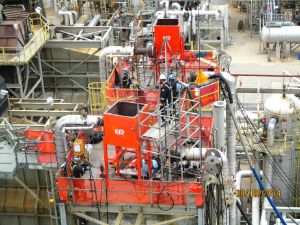 By utilizing a specially-trained workforce and purpose-built equipment, Catalyst handling Resources can execute catalyst projects efficiently and safely, with minimal catalyst attrition and dust elimination control systems.
By utilizing a specially-trained workforce and purpose-built equipment, Catalyst handling Resources can execute catalyst projects efficiently and safely, with minimal catalyst attrition and dust elimination control systems.
At Catalyst Handling we pride ourselves on being able to load any reactor, vessel, or column, on any site. Our equipment is also built to be modular; allowing for ease of transport and set up, yet still creating a smaller onsite presence or “footprint” than traditional catalyst equipment.
Sock Loading Method
Sock Loading involves placing the catalyst into a hopper on the top of the reactor manway and discharging it through a canvas or rubber “Sock”. One end of the Sock is attached to the Loading Hopper discharging pipe.
Dense Loading Method
“Dense Loading” is achieved by a mechanical device that ensures a uniform distribution of catalyst throughout the entire diameter of the reactor, and better total bed density as the catalyst is being loaded. A Dense Loading system can increase the loading density by as much as 10 – 20 percent; depending on the type and shape of catalyst that is being loaded. Dense Loading almost always improves the liquid or gas flow, eliminates catalytic bed settling, and allows for a longer run cycle between catalyst replacements.
CHR has various dense loading methodologies available.
Specialized Reformer Loading
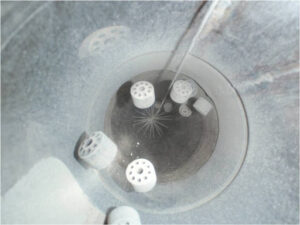 CHR utilizes Unidense™ technology for the loading of primary reformers. This technology allows consistent loading of catalyst into each tube, ensuring that all pressure drops (dP) are within the pre-determined range. Both Unidense™ and Uniloading™ services are available.
CHR utilizes Unidense™ technology for the loading of primary reformers. This technology allows consistent loading of catalyst into each tube, ensuring that all pressure drops (dP) are within the pre-determined range. Both Unidense™ and Uniloading™ services are available.
The loading of Tubular Reformers and all associated mechanical works is provided by our expert teams. Upon completion of a project, all rem
oved catalyst is packaged in UN approved containers ready for shipment or disposal as required.
Dense Phase Loading
Catalyst Handling has been using Dense Phase Loading equipment for over 20 years, and have loaded a variety of reactors without requiring an onsite crane. This process is particularly effective for loading horizontal vessels, Sulfuric Acid Converters, or in situations where high winds and inclement weather are likely to occur.
Please inquire here if dense phase loading is a suitable solution for your catalyst loading project.
Specialized Tubular Reformer Services
Catalyst Handling Resources continues to set new standards in Tubular Reformer services, partnering with LISEGA (USA) and U.S. Thermal Technology Inc. (USA) to offer a complete package of blind to blind services for Tubular Reformers in the oil and gas, petrochemical, and fertilizer industries.
Catalyst Handling Resources has a range of services for the unloading, inspection, maintenance, repair, and loading of tubular reformers. Catalyst loading and the associated mechanical works are completed with our own specialized equipment and we constantly review equipment to incorporate best practice procedures and methods.
Catalyst Handling and Mechanical Services
Catalyst Handling Resources have a well established presence in the Catalyst Handling market, dating back to 1989. Our focus on innovation, safety, quality, and skilled personnel has seen us become a company with in-depth and unparalleled industry experience.
Catalyst Handling Resources use Unidense™ technology for the loading of primary reformers. This technology allows consistent loading of catalyst into each tube, ensuring that all pressure drops (dP) are within the pre-determined range. Both Unidense™ and Uniloading™ services are available.
The loading of Tubular Reformers and all associated mechanical works is provided by our expert teams. Upon completion of a project, all removed catalyst is packaged in UN approved containers ready for shipment or disposal as required.
Specialized Mechanical and Field Services
In addition to the required mechanical works for catalyst removal and loading, a full range of specialized mechanical and field services can also be provided. Inspection of pipelines and pipeline supports, planning and design, installation, and commissioning of reformer systems are all completed with the latest equipment and to strict Quality Assurance standards.
After each project is completed, we conduct a thorough debriefing with clients to identify further improvements, cost savings, and best practices.
Specialized Inspection Services
U.S. Thermal Technology USA specializes in the non-destructive testing of reformer tubes in chemical plants and the oil and gas industry. Catalyst Handling Resources use these technologies as part of preventative maintenance; accurately detecting any defects, irregularities, or areas of concern before they affect plant operations.
US Thermal Technology utilize Eddy Current technology to inspect tubes. This highly accurate method can identify even the smallest changes to tube structure. Video inspection is also integrated into the process, meaning that clients can visually inspect reformer tubes during the scanning process, and all data can be saved to an external hard drive for client record keeping.
Upon completion of the scans, detailed reports are created for clients. These reports provide an instant overview of the condition of a reformer bed, as well as in-depth detail of each tube scanned. This approach ensures that only the necessary remediation or direct inspections are completed, eliminating needless maintenance costs.
Innovation
Catalyst Handling Resources has always prided itself on its ability to innovate and adapt to the situation at hand. This has led to the development of many new pieces of equipment and tools, as well as new processes and systems. A focus on constant innovation and improvement has resulted in Catalyst Handling Resources being one of the safest and most efficient companies in the industry today.
Some of our developments in Catalyst Handling and Mechanical services include:
- Modular Catalyst Vacuum Systems, with only a small site footprint, enable the vacuum removal of catalyst in large multi bed reactors, while cooling, filtering and recycling nitrogen. These can be used effectively in all locations.
- Modular Life Support Systems meeting all international and client safety requirements. Reactor entries can be managed from the ground or reactor top with full video and audio communication and recording.
- Dense Phase Loading systems for the transfer of catalyst directly from grade to reactor manway, without the use of Cranes and Hoppers.
- Automated drum decanting systems reduce drum handling labor and time required, while improving safety.
Ammonia Converters
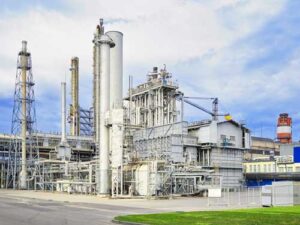
Catalyst Handling Resources has over 20 years experience in ammonia synthesis reactors, vertical and horizontal, and all types of radial flow reactor services. These services range from full mechanical turn arounds to catalyst unloading and loading. CHR has the capability to weld and make internal modifications under inert atmosphere.
We have experience with all major converter designs including Haldor Topsoe, Casale and KBR.
Cleaning and Passivation
CHR offers specialized cleaning for inspection or repair purposes. The most common methods are High Pressure and Ultra High Pressure water blasting, grit, dry ice, or carb-soda blasting.
Passivation Methods
Depending on the metallurgy and process type, some reactors may require passivation of internal components and interior walls to neutralize acids that form from fluorides, chlorides, and sulfur compounds inherent in the process. If necessary a soda ash solution is applied either by a circulation system using a three dimensional spraying head, or by flooding the reactor. Afterwards the reactor can be dried by hot or ambient air circulation. CHR has specialized pumps and spraying nozzles for reactor passivation purposes.
Immediately after the reactor is unloaded it should be internally cleaned to remove any residual catalyst or other foreign particles. The type of process or reactor will often dictate the type of cleaning required.
 Shutdown and Turnaround
Shutdown and Turnaround
CHR combines purpose-built equipment and highly-skilled, fully-utilized teams. This allows us to deliver a wide range of services, from project planning and estimating, through safety and quality planning, and ultimately the execution of the work, ensuring a rapid turnaround with minimum downtime for our clients.
Planning and Management
CHR has the ability to put our experts on site months in advance of a shutdown; planning, organizing, and managing our people and subcontractors from start to finish.
Combining our holistic approach to managing shutdowns with our multi-skilled workforce means we are able to provide a ‘blind to blind’ service; completing the entire project from planning, through to the final stages before the plant is reactivated.
By providing or managing all parties, CHR operates rapidly, adapts to changing circumstances and requirements faster, and still be one of the safest companies in the industry today.
Cost Effectiveness
CHR can become involved at any stage from planning though execution of a turnaround. Our unrivalled ability to offer a ‘blind to blind’ service means that we provide input at every stage of the turnaround, ultimately helping our client to diminish cost, time, and organizational barriers.
We work closely with the client from beginning to end, placing a keen focus on the debriefing stage of a turnaround, and identifying further improvements, cost savings, and best practices.
Innovation
CHR is distinguished in the marketplace by the ability to innovate and adapt to the situation at hand. This has led to the development of many new equipment and tool designs, as well as new processes and systems. Focus on constant innovation and improvement results in CHR being known as one of the safest and most efficient companies in the industry today.
CHR is developing systems for unloading and loading reactors with reduced man-entry requirements.
New developments in Catalyst Handling and Mechanical services include:
Modular Catalyst Vacuum Systems, featuring a small site footprint, enable the vacuum removal of catalyst in large multi bed reactors, while cooling, filtering and recycling nitrogen. These can be used effectively in all locations.
Modular Life Support Systems meeting all international and client safety requirements. Reactor entries can be managed from the ground or reactor top with full video and audio communication and recording.
Nitrogen Recirculation System: Safe and significantly reducing N2 costs
Camera Systems for high resolution and clear monitoring and video production.
Automated Drum Decanting Systems reduce drum handling labor and time required, while improving safety.
Dense Phase Loading Systems for the transfer of catalyst directly from grade to reactor manway, without the use of cranes and hoppers.
